Oceanography & Fisheries Open AccessJournal Juniper Publishers
Authored by Sandeep Munjpara*
Abstract
The Gulf of Kachchh is endowed with a variety of habitats and supports diverse groups of fauna, both invertebrates and vertebrates. The present study was carried out to study distribution of marine and coastal herpetofauna (Amphibians and Reptiles) from the Gulf of Kachchh (GoK). During the study a total of 28 species of herpetofauna were recorded from the GoK, of which, 3 were amphibians (only Anuran) and 25 were reptiles. Among the all recorded species, five species such as Green Sea Turtle, Olive Ridley, Yellow Sea Snake, Annulated Sea Snake and Gerard’s Mud Snake were obligatory marine reptiles. In addition, three other species viz., Saw-scaled Viper, Fringed-toed Lizard and Jerdon’s Snake eye were also recorded. These species are not obligatory marine but observed to be inhabited in the sea-affected habitats, such as Islands and coastal shoreline
Keywords: Herpetofauna; Gulf of Kachchh; Marine Reptiles; Coastal Shoreline.
Introduction
Reptiles and amphibians (collectively called herpetofauna) constitute important elements of biotic components of various ecosystems because they occupy a variety of habitats/micro-habitats [1]. Moreover, being ectothermic animals, they are more susceptible to changes in their environment [2]. As herpetofaunal species are less mobile compared to mammals and birds, alteration in their habitats/micro-habitats can lead to drastic changes in the herpetofaunal communities [3]. Therefore, they are the best indicators of environmental changes. The Gujarat has diversity of herpetofauna, as the state has diverse climatic conditions, ecosystems and habitats. Gujarat State has the longest coastline in the country having two Gulfs i.e., the Gulf of Kachchh (GoK) and the Gulf of Khambhat (GoKh). Varieties of ecosystems and habitats of the Gulf of Kachchh (GoK) support enormous faunal species of invertebrates and vertebrates. The GoK is feeding and breeding ground for many small and large sized creatures. Even though, very few studies are available on occurrence and distribution of herpetofauna of the Gulf of Kachchh.
Most of the available studies are on marine turtles. Bhaskar [4], Kar & Bhaskar [5] and Bhaskar [6] revealed the occurrence of Green Sea Turtles, Olive Ridley, Leatherback and Hawksbill in Gujarat. Of the four species, nesting of only Green Sea Turtle and Olive Ridley was documented, while Leatherback and Hawksbill were occasionally sighted by local fishermen. Additional information on reptiles of Marine National Park (MNP) including seven species of reptiles were reported in marine area of Marine Protected Area (MPA) [7] of which include four species of sea snakes viz., Yellow Snake, Annulated Snake, Bombay sea snake, Many toothed snakes and three species of turtle viz., Green Sea Turtle, Olive Ridley Turtle and Leatherback. Apart from these, nine terrestrial reptiles were recorded in MPA. In present study the entire GoK was studied for occurrence and distribution of marine and coastal reptiles.
Study Area
The study is confined to Gulf of Kachchh, the western most part of Gujarat State, India which encompasses an area of around 7,350 km2 [8]. Biogeographically, the area falls under the sub-biotic province - 8A1 (Gulf of Kachchh) of province - 8A (West Coast) of Zone - 8 (The Coast of India) [9]. A cluster of nearly 42 islands are present in the southern part of the Gulf. Most of the intertidal areas in the southern part have been notified as Marine National Park (162.89Km2) and Marine Sanctuary (457.92Km2) [10,7]. The coastline of the GoK extends up to Kori creek in the north and Okhamadal in the south. However, the present study area was conducted between 22o 08’ N and 23o 14’ N latitude and between 68o 55’E and 70o 48’ E longitude (Figure 1). The study was conducted on islands, intertidal and coastal areas. The area under the observation was mainly 500m landwards side and 200m seaward side from HTL. Along with this, 14 islands were also considered for taking observations. Administratively, the southern part of GoK comprised of 7 talukas viz., Okhamandal, Kalyanpur, Khambhalia, Lalpur, Jamnagar, Jodiya and Maliya. Likewise, the northern part of the GoK comprised of 6 talukas viz., Bhachau, Gandhidham, Anjar, Mundra, Mandvi and Abdasa (Figure 1).
Methodology
Line-transect method was used for spatial and temporal observations during October 2011 to December 2014. A total of 87 transects were laid covering 13 talukas and 14 islands. Spatial distribution of transect and points were carried out through systematic grid sampling (Grid of 5km x 5km) strategy. Cumulative length of transects was 160.70 km and length of each transect varying from 1.5 km to 2.5 km. Apart from 87 transects, 34 points were also laid for observations at wetlands mainly freshwater habitat adjacent to coastal shoreline. Temporal observations were seasonal, i.e. summer, winter and monsoon. In addition to line transects, marine reptiles were also searched through boat survey.
Results and discussion
A total of 28 species of herpetofauna (Amphibians and reptiles) belonging to 16 families were recorded from the study area. Only members of order Anura which includes frogs and toads were recorded from the study area. Three species of the order Anura viz., Common Indian Toad, Indian bullfrog and Jordon’s bullfrog were recorded. Mostly, they were recorded in vicinity of freshwater habitats, located nearby coastline. Of the total 28 herpetofauna, 25 species of reptiles belonging to 23 genera and 14 families were recorded. Lizards and snakes constituted major reptilian groups with 8 and 12 species respectively, (Table 1). Moreover, four species of order Testudines viz., Indian Star Tortoise, Indian Flap-shelled Turtle, Green Sea Turtle and Olive Ridley and one member of family Scincidae viz., Brahminy Skink were also recorded from the study area (Table 1). The Gujarat has records of 107 species of reptiles so far [11], hence it can be implied that the studied GoK comprises of 23.4% of total reported reptilian species. Furthermore, considering 127 herpetofaunal species recorded in Gujarat [11,12], the GoK is inhabited by 22% species of total herpetofauna species. Among the all recorded species, 4 species viz., Chelonia mydas (Green Sea Turtle), Lepidochelys olivacea (Olive Ridley), Varanus bengalensis (Common Indian Monitor), Lissemys punctate (Indian Flapshelled Turtle) are listed as Schedule-I species under the Indian Wildlife (Protection) Act, 1972 [13]. Likewise, according to IUCN (2018.1), Chelonia mydas (Green Sea Turtle) is an Endangered species whereas, Geochelone elegans (Indian Star Tortoise) and Lepidochelys olivacea (Olive Ridley) are Vulnerable [14].
Marine Reptiles of the GoK
Among the recorded reptilian species of the GoK, five species were obligatory marine that includes Green Sea Turtle, Olive Ridley, Yellow Sea Snake, Annulated Sea Snake and Gerard’s Mud Snake. In addition to these, three other species of reptiles were also recorded which do not live in the sea but live in the seaaffected habitats, such as Islands and coastal shoreline. These species were Saw-scaled Viper, Fringed-toed Lizard and Jerdon’s Snake eye. Among the all marine reptile’s Green sea turtle and Saw-scaled Viper were the most abundant in the GoK. Green sea turtle was recorded mainly in vicinity of Kalubhar, Pirotan, Narara and Paga islands (Figure 2). The species recorded mainly from mangrove habitats, openwater and sandy beaches of the GoK. Though Saw-scaled viper is not obligatory marine species, it was recorded from islands and shore land, especially on mangroves and other shrubs and halophytes which frequently inundated by tidal water. Annulated sea snake was also recorded to be distributed widely in the GoK, mostly offshore. Likewise, Gerard’s Mud Snake (Gerarda prevostiana) was recorded near Mandvi beach in Kachchh district (Northern GoK). The species was previously documented in the Gulf of Khambhat. During the study, a crawling trail of Olive Ridley Turtle was recorded from sand-dunes of Okhamandal coast of Devbhumi Dwarka district (Figure 2).

The distribution map of the marine reptiles reveals that the southern part of the GoK, especially, island clusters near Poshitra, Kalubhar and Pirotan had rich species diversity compared to the northern GoK. Nevertheless, coastal area of Mandvi and Abdasa has sand-dunes, covered with sparse vegetation. Such habitats were observed to be inhabited by Jerdon’s Snake-eye as well as Fringed-toed Lizard. The seascape of the Gulf of Kachchh is endowed with many habitats such as offshore, mangrove, coral reef, tidal mudflats, saltpans, coastal shoreline etc. In addition, several habitats adjacent to coastal shoreline also exist which include open land, scrubland, agriculture, freshwater wetlands etc. Diverse habitats of the GoK attract many species of fauna including reptiles. Four species of marine reptiles i.e., Green Sea Turtles, Olive Ridley, Leatherback and Hawksbill were recorded the GoK. Of these, nesting of only Green Sea Turtles and Olive Ridley was reported from both the northern and the southern GoK [4,5,6,15] (Figure 2).
Conclusion
Ecosystem and habitat diversity of the GoK provide excellent feeding and breeding ground for many marine reptiles. Green sea turtle, obligatory marine species, was the widely distributed reptilian species of the GoK. Similarly, Saw-scaled Viper, inhabitant of mangrove vegetation on islands and sea-affected habitats, was also widely distributed species. Apart from the offshore area, the coastal shoreline is also important habitat for many species such as Jerdon’s Snake-eye as well as Fringed-toed Lizard. Freshwater habitats adjacent to coastal shoreline are habited amphibians (Table 1) (Figures 3-8).
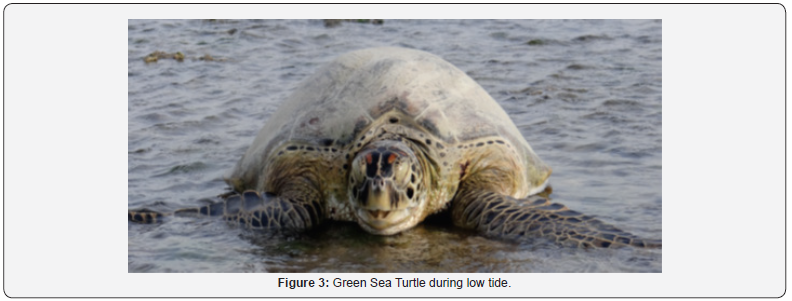
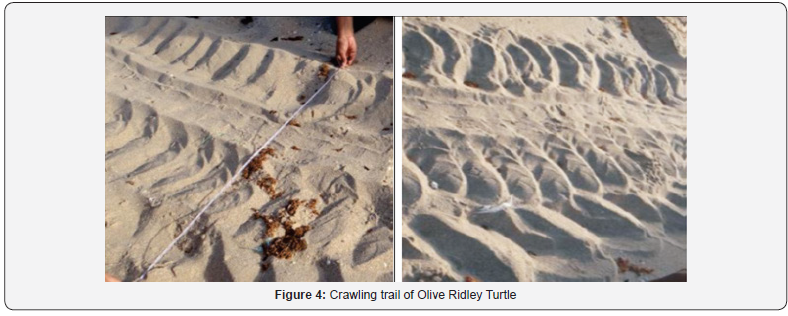
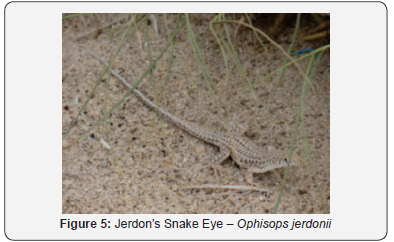
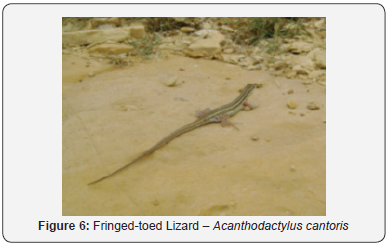
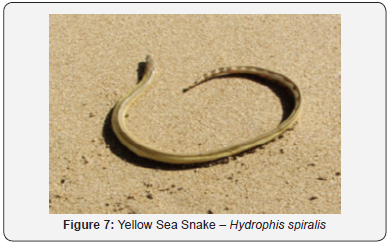
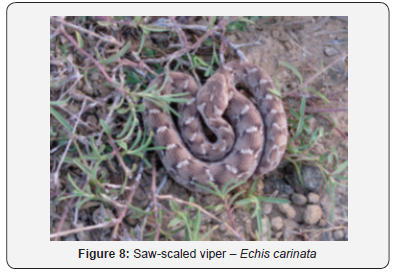
Acknowledgement
Thanks are due to The World Bank, the Ministry of Environment, Forests and Climate Change, Government of India and Environment and Forest Department, Government of Gujarat for financially supporting Integrated Coastal Zone Management (ICZM) Project. The help received from Gujarat Ecological Commission, the State Project Management Unit of the ICZMP of Gujarat State is duly acknowledged. Our deep gratitude towards the officers & field staff of Marine National Park and Sanctuary, Jamnagar and Kachchh circle for their help during field visits. Special thanks to Mr. Rakesh Patel and Mr. Harshad Patel for preparing maps. Thanks, are also due to the former project staff members Mr. Shivbhadra Jadeja, Ms. Kamini Patel, Mr. Nisarg Chaudhari Mr. Bhavesh Parmar and Mr. Yashpal Anand for contributing during field data collection of the project.
To
Know More About Oceanography & Fisheries Open Access Journal Please Click
on:
https://juniperpublishers.com/ofoaj/index.php
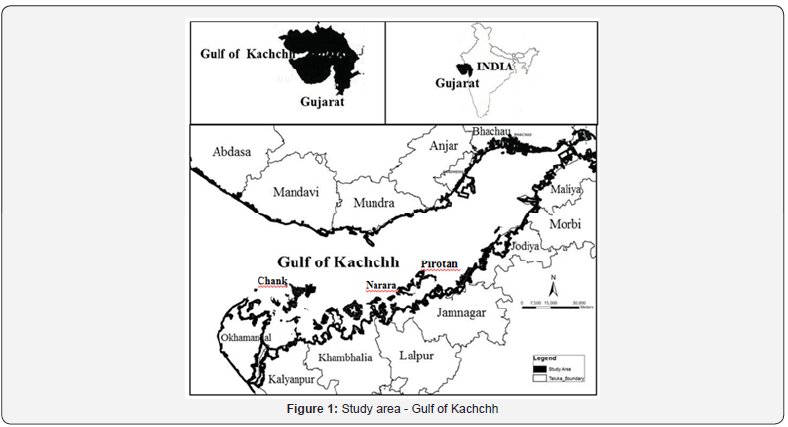




No comments:
Post a Comment